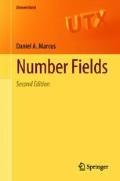Abstract
Fermat’s last theorem is used to motivate the introduction of certain number fields.
Access this chapter
Tax calculation will be finalised at checkout
Purchases are for personal use only
Notes
- 1.
Fermat’s last theorem was finally proved in 1993-94 by Andrew Wiles using concepts from the theory of elliptic curves.
- 2.
\(\mathbb {Q}[\omega ]=\{a_0 + a_1\omega +\cdots +a_{p-2}\omega ^{p-2}:a_i \in \mathbb {Q}\, \forall i\}\);
\(\mathbb {Z}[\omega ]=\{a_0 + a_1\omega +\cdots +a_{p-2}\omega ^{p-2}:a_i \in \mathbb {Z}\, \forall i\}\).
- 3.
In fact, this discovery is due to Kummer. See Harold Edwards’ book review in the Bulletin of the American Mathematical Society, 2 (1980), p. 327.—Ed.
Author information
Authors and Affiliations
Corresponding author
Rights and permissions
Copyright information
© 2018 Springer International Publishing AG, part of Springer Nature
About this chapter
Cite this chapter
Marcus, D.A. (2018). A Special Case of Fermat’s Conjecture. In: Number Fields. Universitext. Springer, Cham. https://doi.org/10.1007/978-3-319-90233-3_1
Download citation
DOI: https://doi.org/10.1007/978-3-319-90233-3_1
Published:
Publisher Name: Springer, Cham
Print ISBN: 978-3-319-90232-6
Online ISBN: 978-3-319-90233-3
eBook Packages: Mathematics and StatisticsMathematics and Statistics (R0)

